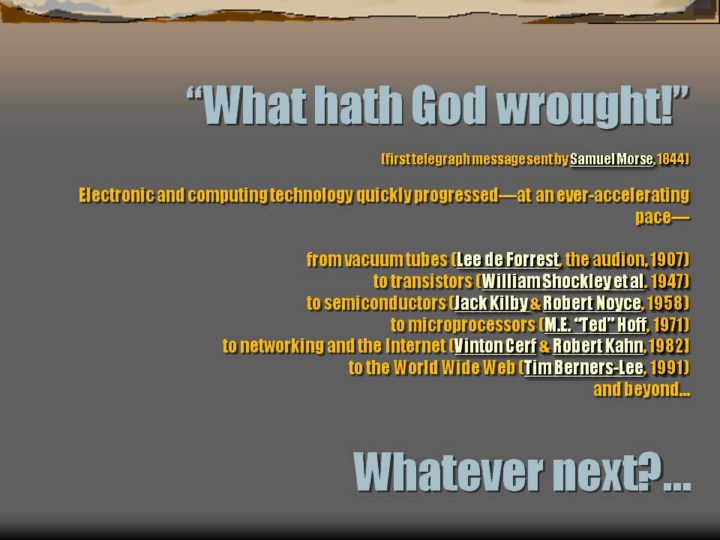| front |1 |2 |3 |4 |5 |6 |7 |8 |9 |10 |11 |12 |13 |14 |15 |16 |17 |18 |19 |20 |21 |22 |23 |24 |25 |26 |27 |28 |29 |30 |31 |32 |33 |review |

(first telegraph message sent by
Samuel
Morse, 1844) |
The ABC and the ENIAC used vacuum tubes, invented by Lee de Forrest, for the Central Processor. William Shockley and his team at Bell Labs invented the transistor in 1948 and IBM soon used these much smaller electronic switching devices in place of vacuum tubes in their computers of the 1950s and 60s.
Speed, in electronic terms, is essentially a function of space. If you can pack the memory components closer together, you increase the speed of the machine. The transistor was a fraction the size of a vacuum tube and thus enabled significant advances in computing power.
Then Kilby and Noyce, who founded Intel Corporation, invented the semiconductor which led directly, in 1971, to Hoff’s invention of the first microprocessor, also at Intel. The semiconductor is the equivalent of a transistor, only it’s layered onto a thin sliver of silicon using photomasking techniques. It revolutionized the computer industry, leading quickly to the invention of the pocket calculator, the personal computer, and the proliferation of computing devices throughout the manufacturing industry.
The Internet began in 1969 as ARPANet, a project of the Advanced Research Projects Agency (ARPA). One of the ideas behind its development was to build a fail safe communications network that the military establishment of the U.S. and allies could rely on in the event of nuclear war. During his tenure from 1976-1982 with the U.S. Department of Defense's Advanced Research Projects Agency (DARPA), and under the leadership of Dr. J.C.R. Licklider, Vinton Cerf played a key role leading to the development of Internet and Internet-related data packet and security technologies, including the design and definition of the TCP/IP set of protocols for the Internet. These protocols were officially adopted in 1982, the year the Internet as such was born.
In 1991, the set of standards for the World Wide Web, now controlled by the World Wide Web Consortium (aka W3C on the web at http://www.w3.org) were launched. These standards were developed by Tim Berners-Lee who is recognized as the inventor of the World Wide Web. To quote from his official bio, which can be found at http://www.w3.org/People/Berners-Lee/Longer.html:
“In 1989, [Tim Berners-Lee] proposed a global hypertext project, to be known as the World Wide Web. Based on the earlier "Enquire" work, it was designed to allow people to work together by combining their knowledge in a web of hypertext documents. He wrote the first World Wide Web server, "httpd", and the first client, "WorldWideWeb" a what-you-see-is-what-you-get (WYSIWYG) hypertext browser/editor which ran in the NeXTStep environment. This work was started in October 1990, and the program "WorldWideWeb" first made available within CERN in December, and on the Internet at large in the summer of 1991.”
Today, you’ll find computers everywhere you care to look and they are controlling an increasingly broad spectrum of the devices we use as we go about our daily lives.
And we ain’t seen nuthin’ yet. |